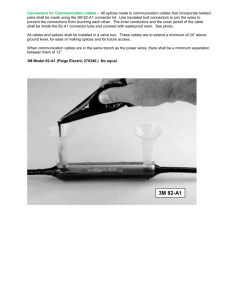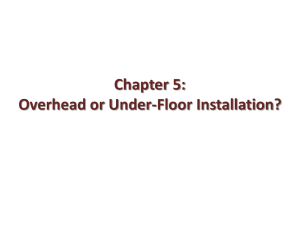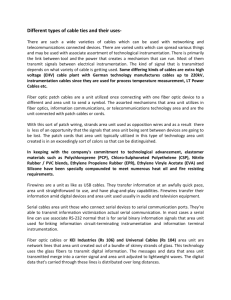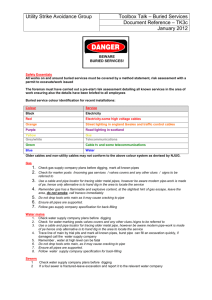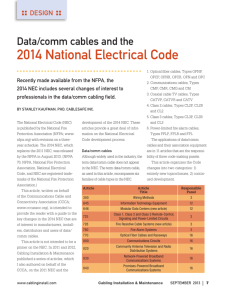Abandoned Cables and 2002 NEC
advertisement
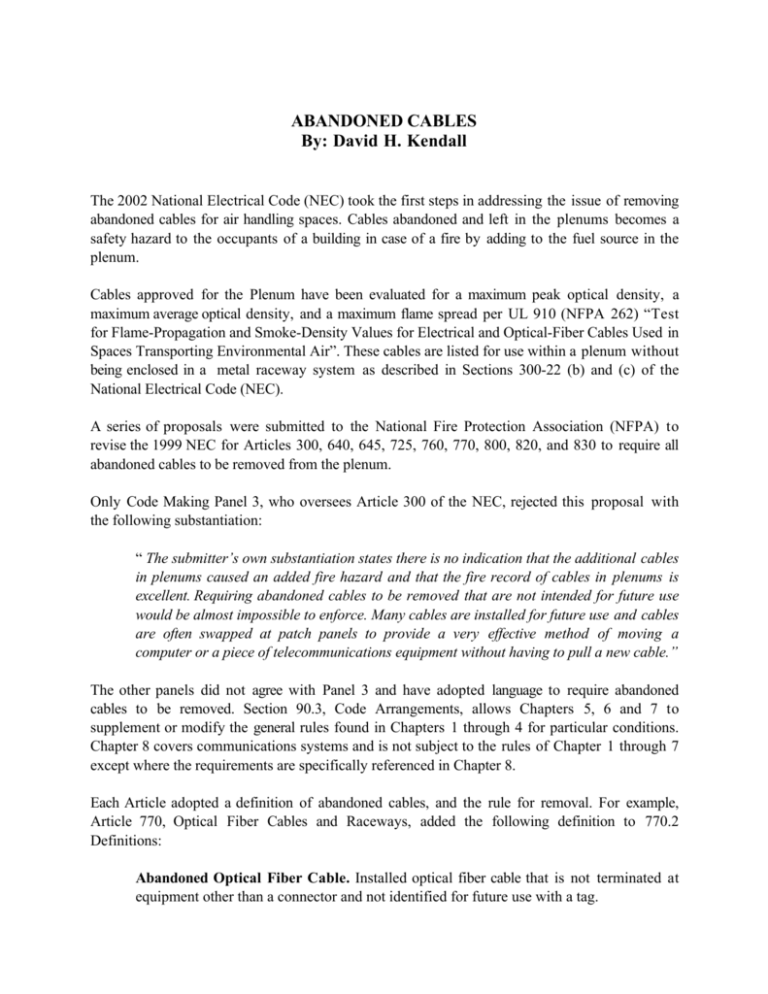
ABANDONED CABLES By: David H. Kendall The 2002 National Electrical Code (NEC) took the first steps in addressing the issue of removing abandoned cables for air handling spaces. Cables abandoned and left in the plenums becomes a safety hazard to the occupants of a building in case of a fire by adding to the fuel source in the plenum. Cables approved for the Plenum have been evaluated for a maximum peak optical density, a maximum average optical density, and a maximum flame spread per UL 910 (NFPA 262) “Test for Flame-Propagation and Smoke-Density Values for Electrical and Optical-Fiber Cables Used in Spaces Transporting Environmental Air”. These cables are listed for use within a plenum without being enclosed in a metal raceway system as described in Sections 300-22 (b) and (c) of the National Electrical Code (NEC). A series of proposals were submitted to the National Fire Protection Association (NFPA) to revise the 1999 NEC for Articles 300, 640, 645, 725, 760, 770, 800, 820, and 830 to require all abandoned cables to be removed from the plenum. Only Code Making Panel 3, who oversees Article 300 of the NEC, rejected this proposal with the following substantiation: “ The submitter’s own substantiation states there is no indication that the additional cables in plenums caused an added fire hazard and that the fire record of cables in plenums is excellent. Requiring abandoned cables to be removed that are not intended for future use would be almost impossible to enforce. Many cables are installed for future use and cables are often swapped at patch panels to provide a very effective method of moving a computer or a piece of telecommunications equipment without having to pull a new cable.” The other panels did not agree with Panel 3 and have adopted language to require abandoned cables to be removed. Section 90.3, Code Arrangements, allows Chapters 5, 6 and 7 to supplement or modify the general rules found in Chapters 1 through 4 for particular conditions. Chapter 8 covers communications systems and is not subject to the rules of Chapter 1 through 7 except where the requirements are specifically referenced in Chapter 8. Each Article adopted a definition of abandoned cables, and the rule for removal. For example, Article 770, Optical Fiber Cables and Raceways, added the following definition to 770.2 Definitions: Abandoned Optical Fiber Cable. Installed optical fiber cable that is not terminated at equipment other than a connector and not identified for future use with a tag. The rule was added to 770.3(A): (A) Spread of Fire or Products of Combustion. The requirements of 300.21 for electrical installations shall also apply to installations of optical fiber cables and raceways. The accessible portion of abandoned optical fiber cable cables shall not be permitted to remain. Several organization such as BICSI, TIA and NECA are working on designing a “Tag” that would be acceptable for identifying a cable intended for future use. Article 645 for Information Technology Equipment, indicates that all abandoned cables installed under raised floors shall not be permitted to remain unless contained in metal raceways. A “Tag” indicating future use for abandoned cables will not be considered an option to allow these cables to remain. Architects, designers, engineers and contractors will need to take the abandoned cable rule into account when designing new buildings and retrofitting older buildings. The easiest way to remove and/or replace a cable is to have it installed in a raceway. Each of these Articles defines the raceways acceptable for use in a Plenum. Those raceways defined in Section 300.22, which consists of metal raceways, are permitted to be used with each of these cable installations. Section 645.5(D)(2) expands the types of raceways permitted and allows nonmetallic raceways such as Electrical Nonmetallic Tubing (ENT), Rigid Nonmetallic Conduit (RNC), nonmetallic Wireway and nonmetallic Surface Raceway to be used under a raised floor for information technology equipment. Articles 770 and 800 recognize listed nonmetallic raceways for use in a plenum. These listed raceways are classified under Optical Fiber/Communications Cable Raceway (QAZM) in the Electrical Construction Equipment Directory published by Underwriters Laboratories Inc. Nonmetallic plenum raceways are suitable for use in ducts, plenums or other spaces used for environmental air as described in Section 300.22. These raceways are permitted to be used with Types OFNP and OFCP nonconductive and conductive optical fiber plenum cables as described in Section 770.53(A) and Type CMP communications plenum cable as described in Section 800.53. Nonmetallic plenum rated raceways have the same fire-resistant and low smoke-producing characteristics as the plenum rated cables. These raceways exhibit a maximum peak optical density of 0.5, a maximum average optical density of 0.15, and a maximum flame spread distance of 5 feet when tested in accordance with UL standard UL2024, Optical Fiber Cable Raceway. The 2002 National Electrical Code (NEC) took the first steps in addressing the issue of removing abandoned cables for air handling spaces. Cables abandoned and left in the plenums becomes a 2 safety hazard to the occupants of a building in case of a fire by adding to the fuel source in the plenum. Raceways are the solution to the abandoned cable issue. A building designed or retrofitted with raceways will easily allow the building to be code compliant and up to date with technology as technology continues to grow and obsoletes current optical fiber and communications cabling methods. 3
